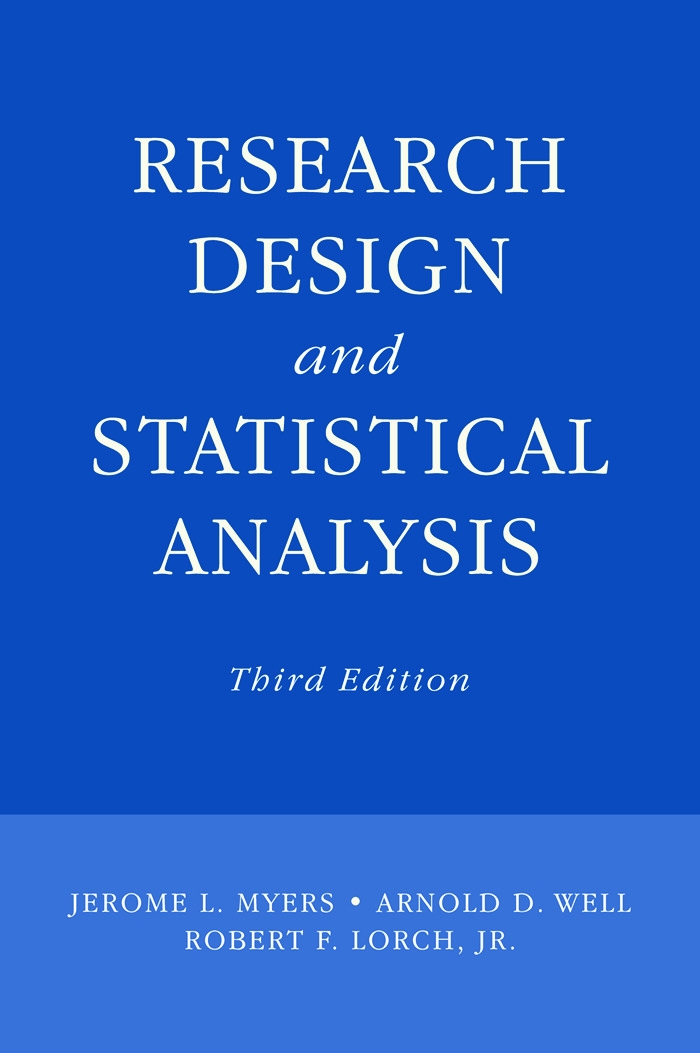"The authors do an exceptional job in covering important topics in a manner that is sophisticated, rigorous, and yet readily accessible. As in previous editions, the authors lay a solid foundation that allows the reader to easily generalize to situations beyond what is covered. The integrative chapters use real data to show how concepts interrelate - what a wonderful idea. The book continues to be a terrific text book for graduate students as well as a valuable resource book for more experienced researchers."Edward J. O'Brien, University of New Hampshire, USA
"I love the `integrated analysis' chapters. They will allow students to practice their new skills, to think critically about data sets, and to learn to write results and discussion sections for papers." Dr. Celia M. Klin, Binghamton University, USA
"The Myers & Well book is the best available book for a one-year graduate statistics sequence...I currently use the 2nd edition...I use it because it provides the best fit for the material I think needs to be covered... and it is an outstanding reference that students should have." William Levine, University of Arkansas, USA
Research Design and Statistical Analysis provides comprehensive coverage of the design principals and statistical concepts necessary to make sense of real data. The book's goal is to provide a strong conceptual foundation to enable readers to generalize concepts to new research situations. Emphasis is placed on the underlying logic and assumptions of the analysis and what it tells the researcher, the limitations of the analysis, and the consequences of violating assumptions. Sampling, design efficiency, and statistical models are emphasized throughout. `As per APA recommendations, emphasis is also placed on data exploration, effect size measures, confidence intervals, and using power analyses to determine sample size. "Real-world" data sets are used to illustrate data exploration, analysis, and interpretation. The book offers a rare blend of the underlying statistical assumptions, the consequences of their violations, and practical advice on dealing with them.
Part 1 reviews research planning, data exploration, and basic concepts in statistics including sampling, hypothesis testing, measures of effect size, estimators, and confidence intervals. Part 2 presents between-subject designs. The statistical models underlying the analysis of variance for these designs are emphasized, along with the role of expected mean squares in estimating effects of variables, the interpretation of interactions, and procedures for testing contrasts and controlling error rates. Part 3 focuses on repeated-measures designs and considers the advantages and disadvantages of different mixed designs. Part 4 presents detailed coverage of correlation and bivariate and multiple regression with emphasis on interpretation and common errors, and discusses the usefulness and limitations of these procedures as tools for prediction and for developing theory.
This is one of the few books with coverage sufficient for a 2-semester course sequence in experimental design and statistics as taught in psychology, education, and other behavioral, social, and health sciences. Incorporating the analyses of both experimental and observational data provides continuity of concepts and notation. Prerequisites include courses on basic research methods and statistics. The book is also an excellent resource for practicing researchers.
| FindBook |
有 1 項符合
Research Design and Statistical Analysis的圖書 |
 |
Research Design and Statistical Analysis 作者:Arnold D./Lorch,Jerome L./Well,Jr.,Myers,Robert F. 出版社:Taylor & Francis 出版日期:2010-05-18 語言:英文 規格:精裝 / 809頁 / 3.8*17.8*24.8 cm / 普級 / 單色印刷 / 再版 |
| 圖書館借閱 |
| 國家圖書館 | 全國圖書書目資訊網 | 國立公共資訊圖書館 | 電子書服務平台 | MetaCat 跨館整合查詢 |
| 臺北市立圖書館 | 新北市立圖書館 | 基隆市公共圖書館 | 桃園市立圖書館 | 新竹縣公共圖書館 |
| 苗栗縣立圖書館 | 臺中市立圖書館 | 彰化縣公共圖書館 | 南投縣文化局 | 雲林縣公共圖書館 |
| 嘉義縣圖書館 | 臺南市立圖書館 | 高雄市立圖書館 | 屏東縣公共圖書館 | 宜蘭縣公共圖書館 |
| 花蓮縣文化局 | 臺東縣文化處 |
|
|
圖書介紹 - 資料來源:博客來 評分:
圖書名稱:Research Design and Statistical Analysis
California Dreaming and Primal Screaming
The Un-Making of Them: Clinical Reflections on Boarding School Syndrome
The Un-Making of Them: Clinical Reflections on Boarding School Syndrome
The Hollow Half
Of My Own Making: How We Choose Who We Become
Trauma Proof: Healing, Attachment, and the Science of Prevention
Imagining the Post-Covid Workplace: Challenges and Opportunities
Imagining the Post-Covid Workplace: Challenges and Opportunities
Sexually and Gender Diverse Adolescents: Critical Perspectives on Risk and Resilience
Sexually and Gender Diverse Adolescents: Critical Perspectives on Risk and Resilience
The Un-Making of Them: Clinical Reflections on Boarding School Syndrome
The Un-Making of Them: Clinical Reflections on Boarding School Syndrome
The Hollow Half
Of My Own Making: How We Choose Who We Become
Trauma Proof: Healing, Attachment, and the Science of Prevention
Imagining the Post-Covid Workplace: Challenges and Opportunities
Imagining the Post-Covid Workplace: Challenges and Opportunities
Sexually and Gender Diverse Adolescents: Critical Perspectives on Risk and Resilience
Sexually and Gender Diverse Adolescents: Critical Perspectives on Risk and Resilience
|










